Previous: Hopper architecture (4)
Hopper people
Post #1008 • May 24, 2007, 6:04 PM • 13 Comments
Boston—Sacrilege, sure, but it's all in the name of research:
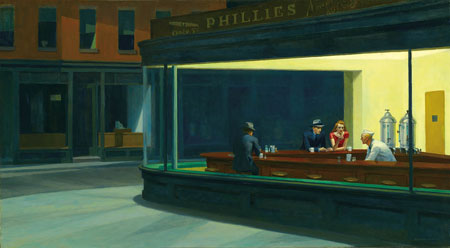
Edward Hopper: Nighthawks, 1942, oil on canvas, The Art Institute of Chicago, Friends of American Art Collection, photography © The Art Institute of Chicago, courtesy, Museum of Fine Arts, Boston
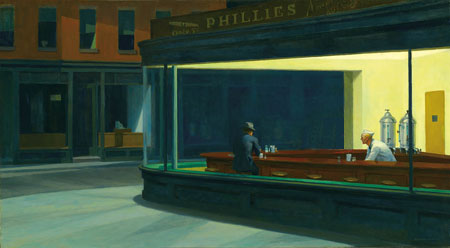
above, retouched
I think this is a useful game to play in general with Hopper, just to determine the extent to which architecture, rather than figures, carry the day - not totally, and not in every piece, but frequently enough that the handling of the figures is evidently architectural out of necessity. And yet, the anomie is real, not bolted on, and neither are the figures conveying it. Paul Cadmus, Reginald Marsh, and George Bellows, all contemporaries, lived in a more boisterous world. In Hopper, there is sadness, but not merely that - there is a reflective order that would have suited Piero.
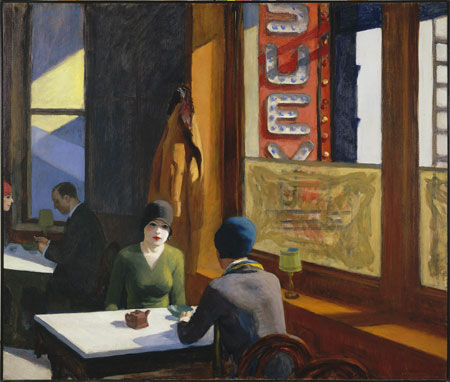
Edward Hopper: Chop Suey, 1929, oil on canvas, collection of Mr. and Mrs. Barney A. Ebsworth, courtesy, Museum of Fine Arts, Boston
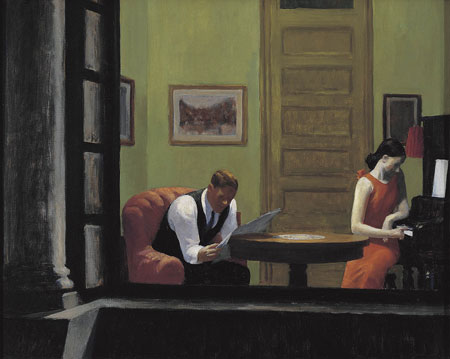
Edward Hopper: Room in New York, 1932, oil on canvas, Sheldon Memorial Art Gallery and Sculpture Garden, University of Nebraska, Lincoln. UNL-F. M. Hall Collection, © Sheldon Memorial Art Gallery, courtesy, Museum of Fine Arts, Boston
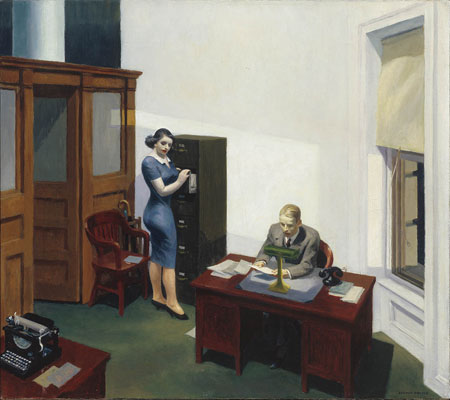
Edward Hopper: Office at Night, 1940, oil on canvas, collection Walker Art Center, Minneapolis. Gift of the T. B. Walker Foundation, Gilbert M. Walker Fund, 1948, courtesy, Museum of Fine Arts, Boston
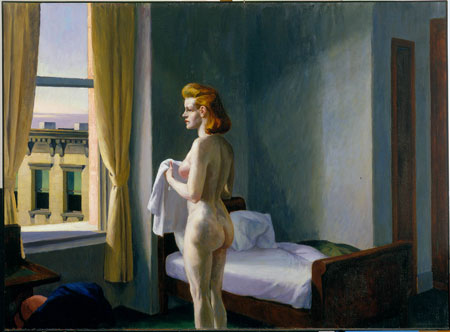
Edward Hopper: Morning in a City, 1944, oil on canvas, Williams College Museum of Art, Williamstown, Massachusetts; Bequest of Lawrence H. Bloedel, Class of 1923, courtesy, Museum of Fine Arts, Boston
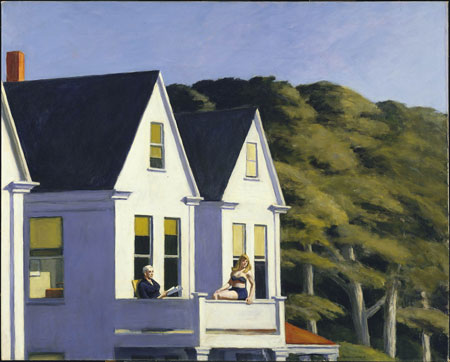
Edward Hopper: Second Story Sunlight, 1960, oil on canvas, Whitney Museum of American Art, New York, purchase, with funds from the Friends of the Whitney Museum of American Art, courtesy of the Whitney Museum of American Art, photograph by Steven Sloman, courtesy, Museum of Fine Arts, Boston
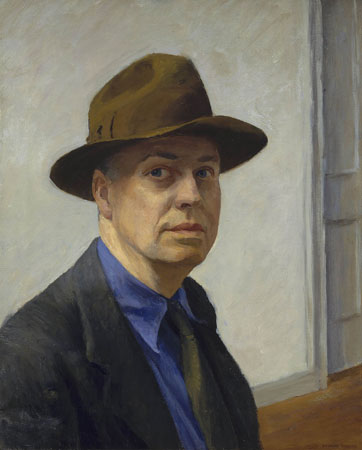
Edward Hopper: Self-Portrait, 1925-30, oil on canvas, Whitney Museum of American Art, New York. Josephine N. Hopper Bequest, © Heirs of Josephine N. Hopper, licensed by the Whitney Museum of American Art; photographs by Robert E. Mates, courtesy, Museum of Fine Arts, Boston
2.
May 24, 2007, 9:52 PM
Hey, let's go all the way. I wonder what the paintings would look like with all the people replaced by fireplugs. OK, seriously, I do think the people break up the work, give it dramatic heft, and help the viewer relate better to the image, but yes, they're pretty much props, and yes, you could probably delete half of them. I've seen many of these works in person at a major retrospective, and the figures just bothered the behexus out of me.
Compositionally Hopper's heirs are photographers like Wall and Crewdson. What saves him for art history as his finest skill is his command of light. Hopper is all about light. Maybe he should not have tried so hard to draw his figures so precisely -- architecturally -- but left them as suggestions. A shadow here, a wisp there, a soft mannequin there.
In the images above, the woman at the piano, the man at the desk, the two diners at the rear of Chop Suey, they can probably all go. In Nighthawks I might argue that the man with his back to us is the expendable one. The couple you deleted are useful for complementing and also contrasting the strong yellow region at right. Whereas the man to the left might have been replaced by, I dunno, a salt shaker or a leather-bound menu. Hey, you started it.
3.
May 24, 2007, 11:30 PM
I often see the light in Hopper’s paintings much the same way as I see the light/cinematography of Robby Muller (Wenders, Jarmusch, and Von Trier). He realized that it is possible to evoke feelings with only a 2-dimensional image and light, and become really interested in the subject. It is possible that Hopper’s interest was the buildings within the landscape and not the people within the buildings. Perhaps Hopper’s interest was the architecture, what he lights, the story.
There is a quote, from somewhere, that reads; what man makes, makes man.
4.
May 25, 2007, 1:48 AM
Perhaps Hopper's interest was badonkadonk...
5.
May 25, 2007, 2:07 AM
The real architecture for me in Hopper is the space between the people, not just the negative space - its design component - but the emotional space, which is , sadly, extensive in most cases .
6.
May 25, 2007, 9:33 AM
How can you forget the Nighthawks with Elvis, James Dean, and Marilyn Monroe? Same painting, same light, but you want to rip it up and run through the night streets with a torch...
7.
May 25, 2007, 9:51 AM
Now, in the exercise above, just take out the man with the woman in the diner, and you have a different context: "Two lonely people meet in a late night diner"
Also, take out the two as before, but turn the waiter around so he is facing the wall. More loneliness.
This one is more to the point:
http://www.geocities.com/Hollywood/6890/yummys.jpg
8.
May 25, 2007, 10:42 AM
I guess it would'nt be titled NIGHTHAWKS if you cold heartedly delete the couple at the counter....it would be titled NIGHTHAWK.
You drained the drama and tension from the work.
I always thought the woman in red was a "working woman" sitting with her pimp and the single man at the counter was about to make a "business transaction".
The painting needs the people, the drama and the tension.
9.
May 25, 2007, 11:15 AM
As someone familiar with the milieu of NIGHTHAWKS, Nighthawk, I can tell you that your scenario is unlikelly. These were war years, and plenty of people worked night shifts.
I would guess all three of them had night jobs; the couple maybe coming off the job and the man going to his, or some such. And the prospect of such a complex liason is not in the spirit of the picture anyway.
10.
May 25, 2007, 1:07 PM
OPie:
And what? People didn't fuck like rabbits during the war years?
11.
May 25, 2007, 2:01 PM
Matbe they did, but that's beside the point. I merely said that based on my experience I thought the scenario was not likely be what the artist indended or observed. You have your own projection on the subject. Let's leave it at that.
12.
May 25, 2007, 2:18 PM
OP:
Dn't tp wth mrbles in yr mth.
13.
May 25, 2007, 2:23 PM
Disemvoweled. I'm not in a patient mood today.
1.
ahab
May 24, 2007, 9:41 PM
In the past few posts' images at least, and like his people, Hopper plantlife seems to suffer just that little bit relative to the excellent architecture and atmosphere and lighting.